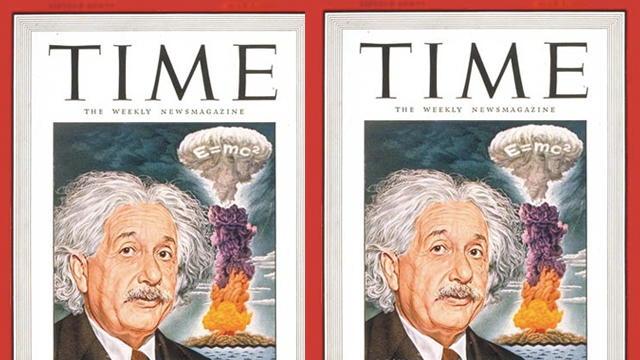Albert Einstein and his equation E=mc² are famously connected to the modern atomic age. But as nuclear historian Alex Wellerstein writes in this counter-factual account of history, the great physicist mattered less than you’d think in the invention of the nuclear bomb.
If Albert Einstein had never been born, would it have changed when nuclear weapons were first produced? For whatever reason, I’ve seen this question being asked repeatedly on internet forums, as odd as it is. It’s kind of a silly question. You can’t go in and tweak one variable in the past and then think you could know what the outcome would be. History is a chaotic system; start removing variables, who knows what would happen. Much less a variable named Albert Einstein, one of the most influential physicists of the 20th century and whose importance extended well past the equations he wrote… and those were pretty important equations, at that!
On the other hand, this kind of science-fiction counter-factual can have its usefulness as a thought experiment. It isn’t history, but it can be used to illustrate some important aspects about the early history of the atomic bomb that a lot of people don’t know, and to undo a little bit of the “great man” obsession with bomb history. Albert Einstein has been associated with the bomb both through his famous mass-energy equivalence calculation (E=mc²) and because of the famous Einstein-Szilard letter to Roosevelt in 1939. On the face of it, this gives him quite a primary role, and indeed, he usually shows up pretty quickly at the beginning of most histories of the Manhattan Project. But neither E=mc² nor the Einstein-Szilard letter were as central to the Manhattan Project’s success as people realise — either scientifically or historically.
In terms of the science, E=mc² gets a lion’s share of attention, most perfectly expressed by Einstein’s portrait on the cover of Time magazine in 1946 (above) with his equation emblazoned on a mushroom cloud. A lot of people seem to think that E=mc² played a key role in the development of the bomb, that the weapon just falls out of the physics. This is wrong. The equation can help one understand why atomic bombs work, but it doesn’t really tell you how they work, or whether you would expect them to even be possible.
The way I like to put it is this: E=mc² tells you about as much about an atomic bomb as Newton’s laws do about ballistic missiles. At some very “low level” the physics is crucial to making sense of the technology, but the technology does not just “fall out” of the physics in any straightforward way, and neither of those equations tell you whether the technology is possible. E=mc² tells you that on some very deep level, energy and mass are equivalent, and the amount of energy that mass is equivalent is gigantic. But it says nothing about the mechanism of converting mass into energy, either whether one exists in the first place, or whether it can be scaled up to industrial or military scales. It gives no hints as to even where to look for such energy releases. After the fact, once you know about nuclear fission and can measure mass defects and things like that, it helps you explain very concisely where the tremendous amounts of energy come from, but it gives you no starting indications.
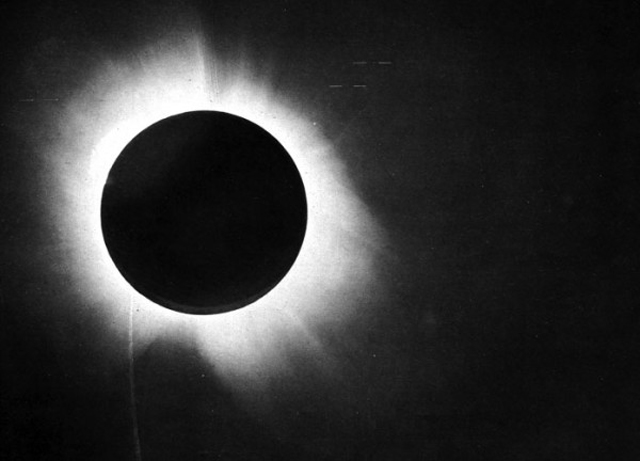
Eddington’s famous plate of the 1919 solar eclipse, which helped confirm Einstein’s theory of General Relativity. Very cool looking, and interesting science. But not relevant to atomic bombs. Source
What about the rest of Einstein’s main theoretical work, both Special and General Relativity Theory? They are pretty irrelevant to bomb-making. The physical processes that take place inside atomic bombs are what physicists call “non-relativistic“. Relativity theory generally only shows its hand when you are talking about great speeds (e.g. large fractions of the speed of light) or great masses (e.g. gravitational fields), and neither of those come into play with fission bombs. You can neglect relativity when doing the maths to make a bomb.1
An intelligent follow-up question might be: “well, just because relativity theory didn’t play a role in the bomb process itself doesn’t answer the question of whether it started physics on a path that led to the bomb, does it?” Without getting into a long timeline of the “science that led to the bomb,” here, I think we could reasonably summarize the situation like this: Einstein’s 1905 papers (of which E=mc² was one) did indeed play a role in the subsequent developments that followed, but perhaps not as direct a one as people think.
E=mc² didn’t inspire physicists to start looking into processes that converted mass to energy — they were already looking into those through an entirely separate (and earlier) line of development, namely the science of radioactivity and particle physics. The fact that huge amounts of energy were released through nuclear reactions, for example, had already been studied closely by the Curies, by Ernest Rutherford, and by Frederick Soddy prior (but only just) to 1905.
Arguably, the most important work Einstein did in this respect was his work on the photoelectric effect (for which he was awarded the Nobel Prize in Physics for 1921), which helped establish the physical reality of Max Planck’s idea of a quantum of energy, which helped kick off investigations into quantum theory in earnest. This had a big influence on the later direction of physics, even if Einstein himself was never quite comfortable with the quantum mechanics that developed in subsequent decades.
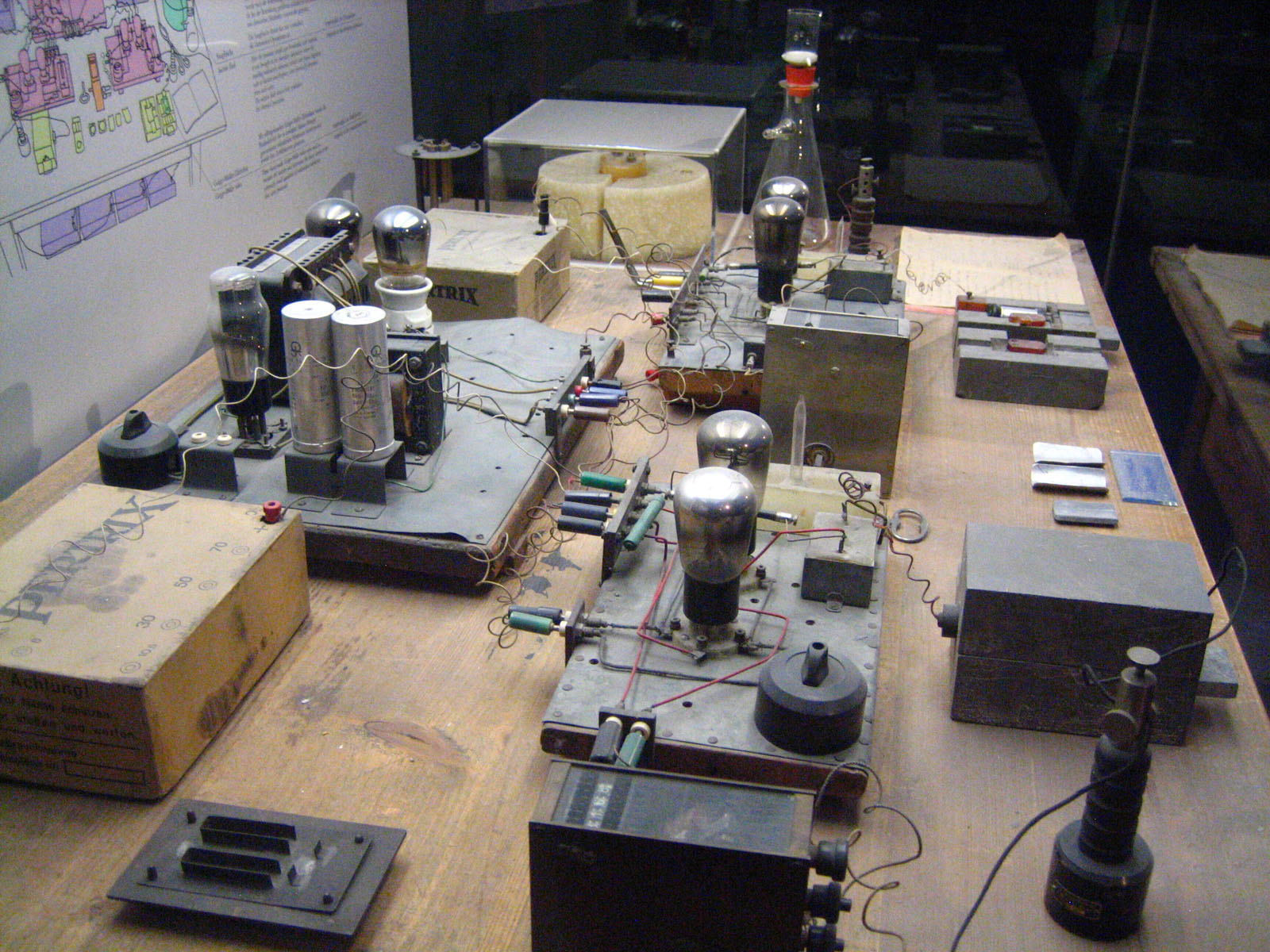
The Hahn-Meitner-Strassman experiment apparatus, at the Deutsches Museum in Munich. My own photo.
Did any of the relativity work lead, though, down the path that eventually arrived at the discovery of fission in 1939? I don’t think so. The experiments that Hahn, Meitner, and Strassman were doing in Berlin that lead to the discovery of fission in uranium were themselves careful replications of work that Fermi had done around 1934. Fermi’s work came directly out of an experimentalist, nuclear physics context where physicists were bombarding substances with all manner of subatomic particles to see what happened. It was most directly influenced by the discovery of the neutron as a new sub-atomic particle by Chadwick in 1932. This came out of work on atomic theory and atomic modelling that was being done by Rutherford and his students from the early 1910s-1920s. And this early nuclear physics came, most directly, out of the aforementioned context of radioactivity and experimental physics of the late 19th century.
None of which has a strong, direct connection to or from Einstein’s work in my mind. They have some overlaps of interest (e.g. Bohr was a student of Rutherford’s), but the communities working on these sorts of experimental problems are not quite the same as the more theoretical circle that Einstein himself worked in.2 If we somehow, magically, removed Einstein’s early work from the equation here, does the output change much? There would be some reshuffling, probably, but I sort of think that Rutherford would still be doing his thing anyway, and from that much of the other work that led to the bomb would eventually come out, even if it had a somewhat different flavour or slightly different timeline.

This is my least-favourite way of depicting the fission process, where energy (E) is a magic lightning bolt coming out of the splitting atom. In reality, most of the energy comes in the form of the two fission products (F.P. here) repelling from each other with great violence. Source.
Do you even need to know that E=mc² to make an atomic bomb? Perhaps surprisingly, you don’t! There are other, more physically intuitive ways to calculate (or measure) the energy release from a fission reaction. If you treat the fission process as being simply based on the electrostatic repulsion of two fission products, you get essentially the same energy output in the form of kinetic energy. This is how the physics of fission is often taught in actual physics classes, because it gives you a more concrete indication of how that energy is getting released (whereas E=mc² with the mass-defect makes it seem like a magical lightning bolt carries it away). There are other more subtle physical questions involved in making a bomb, some of which have Einstein’s influence on them in one way or another (e.g. Bose — Einstein statistics).
But I think it is not totally crazy to say that even if you somehow imagine a world in which Einstein had never existed, that the physics of an atomic bomb would still work out fine — Einstein’s specific technical work wasn’t central to the problem at all. We also have not brought up the question of whether without Einstein, relativity in some form would have been discovered anyway. The answer is probably “yes,” as there were people working on similar problems in the same areas of physics, and once people started paying a close attention to the physics of radioactivity they were bound to stumble upon the mass-energy relationship anyway.
This isn’t to denigrate or underestimate Einstein’s influence on physics, of course. What makes Einstein “Einstein” is that he, a single person, pulled off a great number of theoretical coups all at once. But if he hadn’t done that, there’s no reason to think that other people wouldn’t have come up with his theoretical insights individually, if slightly later.
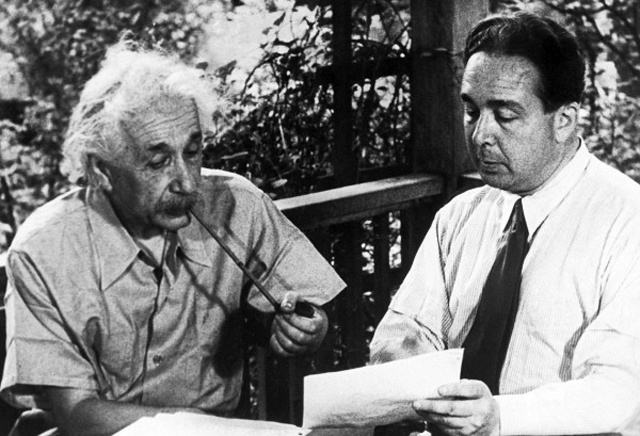
A postwar re-creation of the genesis of the Einstein-Szilard letter.
What about Einstein’s most direct role, the famous Einstein-Szilard letter of 1939 that influenced President Roosevelt to set up the first Uranium Committee? This is a tricky historical question that could have (and may at some point) an entirely separate blog post relating to it. Its writing, contents, and influence are more complex than the standard “he wrote a letter, FDR created the Manhattan Project” understanding of it that gets boiled down in some popular accounts. My feeling about it, ultimately, is this: if the Einstein-Szilard letter hadn’t been written, it isn’t clear that anything would be terribly different in the outcome in terms of making the bomb. Something like the Uranium Committee might have been started up anyway (contrary to popular understanding, the letter was not the first time Roosevelt had been told about the possibility of nuclear fission) and even if it hadn’t, it isn’t clear that the Uranium Committee was necessary to end up with a Manhattan Project.
The road from a fission program whose primary output was reportsand a fission program whose primary output was atomic bombs was not a direct one. By early 1941, the Uranium Committee had failed to convince scientist-administrators that atomic bombs were worth trying to build. They had concluded that while atomic bombs were theoretically feasible, they were not likely to be built anytime soon. Had things stayed there, it seems unlikely the United States would have built a bomb ready to use by July/August 1945.
The “push” came from an external source: the British program. Their MAUD Committee (an equivalent of the Uranium Committee) had concluded that a nuclear weapon would be much easier to build than the United States had concluded, and sent an emissary (Mark Oliphant) to the United States to make sure this conclusion was understood. They caught Vannevar Bush’s ear in late 1941, and he (along with Ernest Lawrence, Arthur Compton, and others) wrested control of the uranium work out of the hands of the Uranium Committee, accelerated the work, and morphed it into the S-1 Committee. The name change is significant — it is one of the more vivid demonstrations of the increased degree of seriousness with which the work was taken, and the secrecy that came with it. By late 1942, the wheels for the full Manhattan Project were set into motion, and the work had become a real bomb-making program.
Einstein wasn’t involved with any of the later work that actually led to the bomb. He almost was, though: in late 1941, Bush considered consulting Einstein for help on the diffusion problem, but opted not to push for it — both because Einstein wasn’t regarded as politically reliable (he had a fat FBI file), and his approach to physics just wasn’t very right for practical problems.3 Bush decided that Einstein would stay out of the loop.
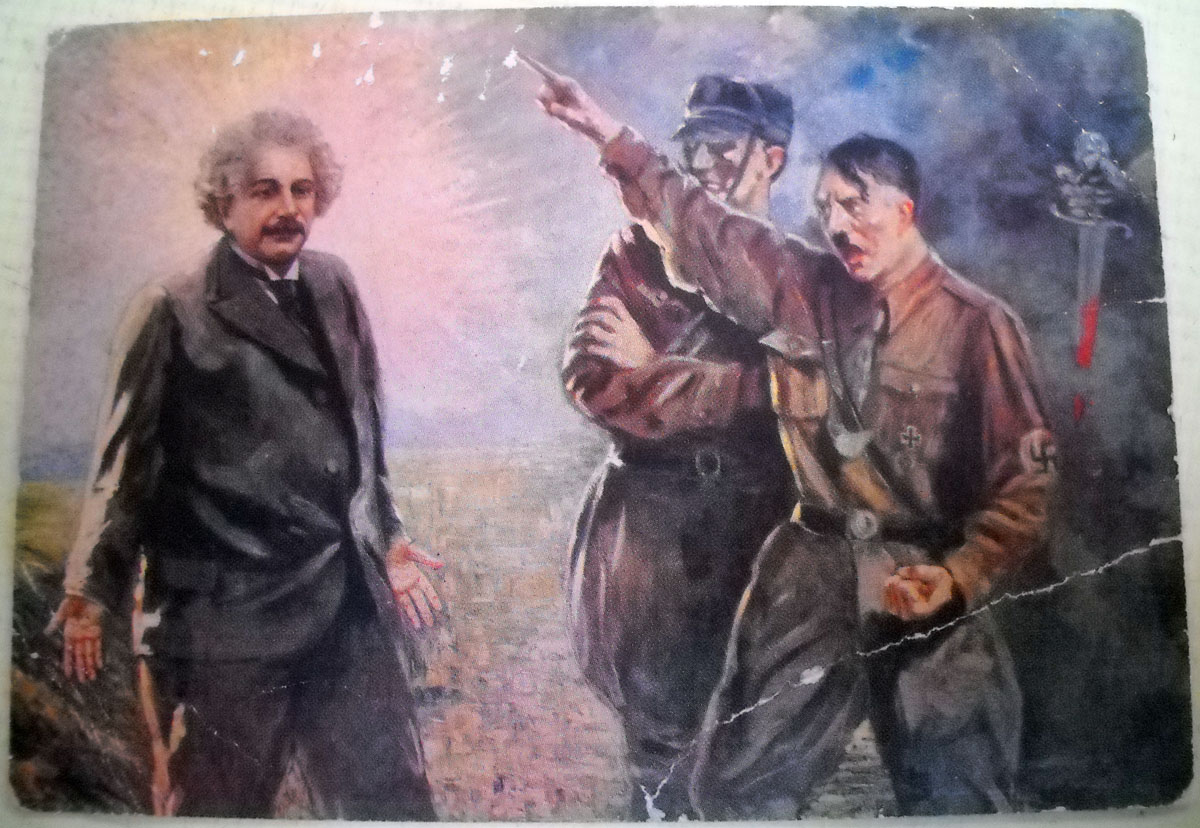
Unusual, rare anti-Nazi propaganda postcard from 1934, showing Hitler expelling Einstein from Germany, titled “The Ignominy of the 20th Century.” It is one of the most blatant visual renderings of Einstein as a “scientific saint.” Source.
Let’s sum it up. Did Einstein play a role in the creation of the atomic bomb? Of course — his physics isn’t irrelevant, and his letter to Roosevelt did start one phase of the work. But both of these things are less prominent than the Time-magazine-cover-understanding makes them out to be. They weren’t central to what became the Manhattan Project, and if you could somehow, magically, remove Einstein from the equation, it isn’t at all clear that the atomic bomb wouldn’t have been built around the time it actually was built. I don’t think you can really credit, or blame, Einstein for the atomic bomb, in any direct fashion. Einstein did play a role in things, but that role wasn’t as crucial, central, or direct as a lot of people imagine. If you could magically drop him out of history, I think very little in terms of atomic bombs would have been affected.
So why does the Einstein and the bomb myth persist? Why does everybody learn about the Einstein letter, if it wasn’t really was sparked the Manhattan Project? There are two answers here, I think. One is that Einstein was, even before the war, one of the best-known, best-recognised physicists of the 20th century, and was synonymous with revolutionary science and genius. Having him “predict” the atomic bomb with equations in 1905 — 40 years before one was set off — is the kind of “genius-story” that people love, even if it obscures more than it enlightens. It also has a high irony quotient, since Einstein was forced to flee from Germany when the Nazis took power.
But there’s another, perhaps more problematic aspect. In many early copies of the Smyth Report that were distributed by the government, copies of the Einstein letter were mimeographed and loosely inserted. The magnification of Einstein’s role was purposefully encouraged by the government in the immediate period after using the weapon. (And it was even a convenient myth for Einstein, as it magnified his own importance and thus potential influence.) Hanging the atomic bomb on Einstein’s head was an act of self-justification, of sorts. Einstein was the world’s greatest genius in the eyes of the public, and he was a well-known pacifist, practically a scientific saint. After all, if Einstein thought building a bomb was necessary, who could argue with him?
Notes
- As Robert Serber puts it: “Somehow the popular notion took hold long ago that Einstein’s theory of relativity, in particular his famous equation E = mc², plays some essential role in the theory of fission. Albert Einstein had a part in alerting the United States government to the possibility of building an atomic bomb, but his theory of relativity is not required in discussing fission. The theory of fission is what physicists call a non-relativistic theory, meaning that relativistic effects are too small to affect the dynamics of the fission process significantly.” Robert Serber, The Los Alamos Primer: The First Lectures on How to Build an Atomic Bomb (University of California Press, 1992), 7.
- For a good, non-teleological, non-bomb-centric approach to the context of 19th- and 20th-century physics, Helge Kragh’s Quantum Generations: A History of Physics in the Twentieth Century (Princeton University Press, 2002), is excellent.
- Einstein wasn’t entirely a head-in-the-clouds physicist, of course. He worked at the patent office, and as Peter Galison has written about, even his famous thought experiments were often motivated by experience with practical problems of time synchronisation. And he did help invent a refrigerator with Leo Szilard. But his work on diffusion physics was too abstract, too focused on first-principle analysis, for use in producing a practical outcome.
Alex Wellerstein is a historian of science who specialises in nuclear weapons history. He is currently at the Center for the History of Physics, at the American Institute of Physics, and is moving this fall to the Stevens Institute of Technology. He writes the blog Restricted Data and is the creator of the NUKEMAP.
